You've probably heard about 7 chakras before in your life.
The chakras are in fact the key points in Eastern philosophies since they are very important energy centers in our body.
My work as a Shamanic Reiki Master is based on the 7 chakras, their cleaning and "re-awakening". In my ceremonies I go to work mainly on these energy centers.
In this article we will see in detail what chakras are, how they work and how to "awaken" them through the practice of reiki and meditation, in order to obtain numerous psycho-physical benefits.
Let's get started now!
Reading Time: 24 minutes
What are the 7 Chakras
Chakra is a Sanskrit word meaning wheel, disc or circle. The Chakras are our vital points and represent the energy centers of our body that have the task of absorbing our vital energy (prana) and redistributing it. Our energy flows through our Chakras.
According to Reiki, in the human being there are about one hundred vital points (the chakras, in fact) located between the vital body and the physical body, whose activation allows you to acquire certain physical and extrasensory capabilities, achieve inner peace and finally reach the awakening of consciousness. The Chakras would then be united to the different bodies of man (astral, mental, causal, ...) through a series of channels called Nadis, real energy highways.
But within this group there are the 7 basic or main Chakras that are distributed from the lower part of the spine, where there is the Kundalini (energy tangled in the shape of a snake, which must be awakened) to the highest part of the head. The energy flows through these channels with ascending and descending movements, while it forms a kind of spiral, turning like a wheel.
The Chakras are also represented with lotus flowers seen from above. For this reason they can also be called Padma, which means "lotus".
Each lotus representing a Chakra also has a different number of petals and a different color and contains different elements, such as a mantra, a letter of the Sanskrit alphabet on the petals or a symbol with a particular meaning.
Each Chakra is also associated with particular elements, such as colors, sounds, stones and so on. But I don't want to anticipate anything: I'll talk about it in a more specific way in the course of this article.
After this introduction, you probably wonder, "Why are Chakras so important to us?"
Well, it's very simple.
The Chakras are fundamental points in our body because they are strong energy centers that connect the various bodies and the psyche.
When the Chakras are open, the energy can flow freely, with positive effects for both the mind and the body. But when they are closed, the energy can no longer flow, forming a blockage that causes negative repercussions on all levels, both physically and psycho-emotionally.
For this reason it is very important that these vortexes of energy remain open and I will soon explain how to do this.
What are the Chakras for?
And now that you know what the 7 chakras are, you may be wondering what they are for: officially the main function of the Chakras is to absorb the universal energy called Prana, metabolize it and feed the different aspects of the human being to finally radiate energy outward. More simply, we can say that the Chakras are energy centers on which depend different functions, not only of the physical body but also of the psyche and subtle bodies.
Below I will describe each of the 7 main Chakras with some of their most used meanings and characteristics, as well as some illnesses and psychological illnesses that could be caused by the bad development of each chakra.
How the 7 Chakras work
The main Chakras are 7 energy centers situated in our body located between the head and the lower part of the spine and are:
Muladhara - Earth or root chakra
Svadhisthana - Water or sacral chakra
Manipura - Solar Plexus or Fire Chakra
Anahata - Heart Chakra
Vishuddha - Cleansing or throat chakra
Ajna - Chakra of the light or of the third eye
Sahasrara - Crown Chakra
These energy centers have the task of receiving energy and redistributing it through the nadis, a sort of channels connected to the spine that have the task of transporting the energy in the rest of the body.
Our goal will therefore always be to maintain the right opening of our chakras, in a balanced way, so that the energy can flow smoothly without energy blocks (closed chakras) or an overload of energy (chakras too open).
Both of these situations can lead to mental and physical discomfort.
Since the chakras are connected to the nerve ganglia and endocrine glands, the closure of the chakras and the resulting energy blockage can cause a state of inner crisis and psychophysical discomfort as well as the onset of pathologies to the organs connected to those glands.
When a chakra is awakened and then opened, we reach a greater awareness of ourselves and a development of precise psychophysical benefits.
Moreover, the chakras are not unrelated but have a strong influence on each other, especially with regard to the chakras close to each other. This means that the opening or closing of a chakra can also have a positive or negative effect on adjacent chakras.
Each chakra, as we have already mentioned, also has a precise color and a stone that represents it. In the course of the article you will also find a technical sheet where you can also find the colors and stones of each chakra.
What does it mean to open the chakras
Now that we have understood what chakras are and how they work, and after observing how important their balance is, we come to a crucial question:
"How to find out if our chakras are blocked? And how do you open them?"
Later, when we describe the individual chakras one by one, I will also give you examples of whether one or more of your chakras are unbalanced.
When a chakra is too closed or too open, in fact, there are some physical, emotional and mental imbalances, a precise practice or meditation can help you solve them.
By realigning the chakras, you will also achieve a balance in your organism, so that your mind and body can live in unison, with all the benefits and positive effects that come with it.
The 7 chakras
Now that we know what chakras are and how they work, let's have a closer look at each of them!
#1 - Muladhara: the root chakra
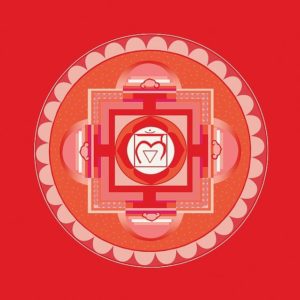
The word Muladhara comes from Sanskrit and literally means "base support".
This chakra is located at the base of the spine, in the perineum. It is the chakra that is connected to the legs and is therefore a symbol of the earth and everything that is solid and stable. For this reason it is also the chakra of all the hardest parts of the body, such as nails, bones and teeth.
It controls different parts of the body such as the nose, sense of smell, lymphatic system, bone system, prostate and lower extremities. It is usually associated with the color red. The root chakra or first chakra symbolizes stability, self-confidence and security and is related to our survival. When it is balanced we feel safe, happy and able to live the present moment, full of enthusiasm and ready to plan our future.
It is in fact essential to have solid roots on which to base our whole life, just as the roots for the survival of a tree or the foundations for building a solid house are fundamental.
When the first chakra is blocked, we can feel lost, apathetic, distrustful and without self-confidence. We will never feel satisfied in one place and we will tend to change house or country often.
Even our body suffers from the blockage of this chakra: we will feel tired and exhausted, we will have problems with our teeth, kidneys and joints.
When it is too open, opposite feelings are unleashed, such as a strong attachment to material goods and the past, without being able to live the present moment.
We oppose to change and we develop a total lack of fear or excessive fear, which can lead us to get into very risky situations or the inability to enjoy the beauty of life.
How to balance the first chakra
To balance the chakras you never have to pretend to be what you are not. For example, you don't have to fake pretending to be happy to align it, but on the contrary, if you manage to rebalance it, you will start to feel happy.
If you can't do a Reiki session, there are several exercises, positions and visualizations you can do to unlock the first chakra.
The first thing I recommend you do is to find a quiet place where you can be in direct contact with the earth, such as a wood or a garden. The garden at home is also fine!
Practice yoga positions that encourage your contact with the earth, such as Vrksasana, the tree position, or Tadasana, the mountain position.
Also do visualization exercises. Sit on the ground with your legs crossed and your back upright. Now visualize roots that start from your body and go deep into the ground.
As the roots go down, they will carry with them all the negative energies you have accumulated. When you feel ready, call back the roots to yourself, which will go back together with the positive energy of the earth.
To help you keep your concentration, you can also listen to the LAM mantra, the mantra corresponding to the first chakra, which you can find in the video below.
You can also open this chakra by walking (e.g. experiencing walking meditation), doing aerobic exercises, flexing your trunk until you touch your toes while sitting, doing dance or dance exercises, jumping on the spot, doing exercises that enhance self-confidence, practicing yoga, etc..
Summary sheet of Muladhara

- Position: In the perineum between the anus and the genitals, at the base of the spine, coccyx
- Function: Survival, Stability, security, self-confidence
- Color: red
- Element: earth
- Sense: smell
- Stones: red jasper, ruby, red coral, garnet, black onyx, oxidania
- Mantra: Lam, S
- Lotus: 4 petals with earth inside
- Note: do
- Animal: ox, bull, elephant (associated with the earth)
#2 - Svadhisthana: the splenic chakra
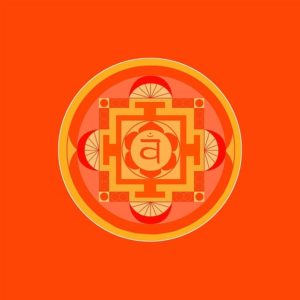
Continuing the journey of ascent of the kundalini, the second chakra we find is the splenic chakra or water chakra. Unlike the first one, which indicates stability, this chakra is associated with liquids and therefore with letting go, with the flow, with the capacity for change.
The second chakra is the fulcrum that connects the soul with the body. It is located in the lower abdomen, just below the navel, and is the chakra of emotions, spontaneity, creativity, pleasure and sexuality.
The splenic or orange chakra is related to the sexual organs, the reproductive system and the lumbar plexus.
When the water chakra is blocked, it is the emotions that are most affected.
We have strong mood swings, we are full of anger, guilt and shame and we are subject to panic attacks. The search for sex is transformed into a mere physical stimulus but without involving emotions. This inevitably leads to unsatisfactory stories with your partners.
Physically, problems and pathologies can occur in the lower abdomen, such as kidney stones and dysfunctions of the reproductive system and the menstrual cycle, as well as fluid flow, such as the circulatory system or the bladder.
Other consequences of splenic chakra malfunction are sexual repression, fear of pleasure, contempt for sex and energy blockages that limit the expression of one's personality.
If the second chakra is too open, there is a search for pleasure and immediate but ephemeral satisfaction, developing emotional addictions or addictions related to food, alcohol, drugs or sex.
How to rebalance the second chakra
To rebalance the second chakra, you will have to work on your emotions and your creativity.
The practice of Reiki will help you to know and manage your emotions. Breathing is also very important to rebalance the splenic chakra. Just like a fluid, in fact, you will have to be able to let the air that you breathe through your whole body flow.
The mantra of the second chakra corresponds to the Sanskrit letter Vam. You can listen to it in this video below.
Listening to this mantra during practice and meditation will help you rebalance the second chakra.
To activate this chakra you can also dedicate yourself to some exercises such as swimming, give yourself long baths, showers, some relaxation in a jacuzzi, or even with dances or dances involving movements and rotations of the pelvis, closely related to sexual relations.
Summary sheet of Svadhisthana
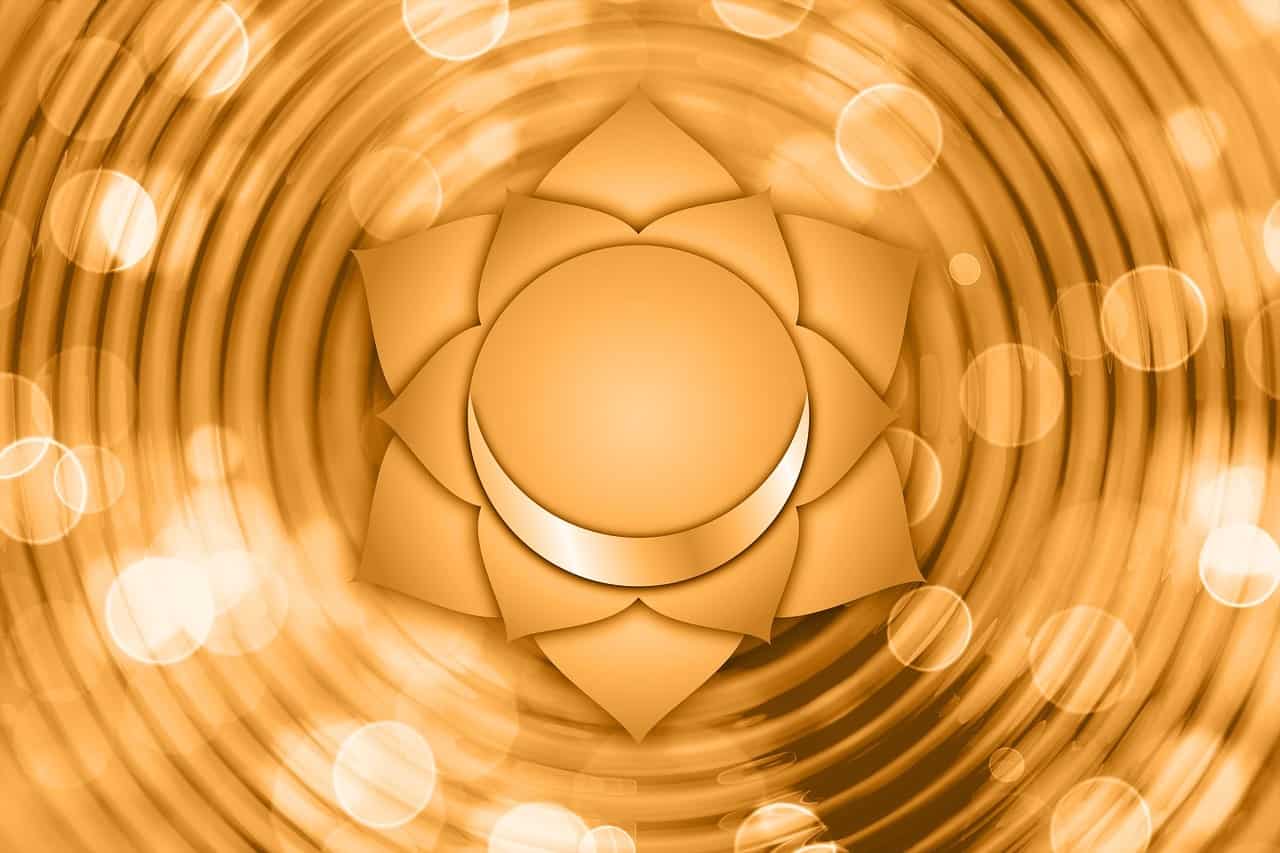
- Position: lower abdomen
- Function: desire and procreation, sexuality, emotions, creativity
- Colour: orange
- Element: water
- Sense: touch and taste
- Stones: amber, citrine, topaz, opal
- Mantra: Vam, M
- Lotus: 6 petals with a half-moon inside
- Note: re
- Animal: crocodile, snake, reptiles, fish
#3 - Manipura: the solar chakra
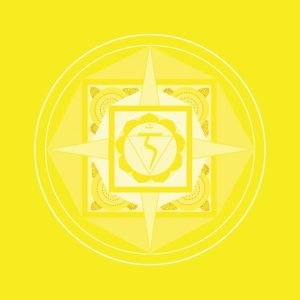
The third chakra, the solar or fire chakra, is located in the solar plexus, the part of the abdomen that lies between the diaphragm and navel, is associated with the yellow color and involves different parts of your body such as the skin, muscle system, stomach, liver, large intestine and glands and organs at the level of the solar plexus. It is also associated with the eyes, the sight and the muscles of the face.
If the first chakra is connected to stability and the second to flow, the third chakra is that of the union of these two elements, namely light, energy, heat and when it is well balanced we feel energetic, self-confident, strong and self-controlling.
We are not afraid of the judgments of others and we know how to always be up to the situation and we have no difficulty in managing ourselves and our emotions.
It is connected to the digestive system and digestion, which "devours" food just as fire devours what it finds in its path.
When the third chakra is unbalanced we can see many negative symptoms, both physically and mentally, especially related to our safety and our digestive system.
When it is too closed, in fact, we notice the rise of insecurity, low self-esteem, introversion and a strong sense of inadequacy in all situations. On the physical level, however, problems arise such as liver disorders, nausea, ulcers, gastritis, difficulty digesting and coeliac disease.
Problems can also appear when this chakra is too open, making a person appear very arrogant, aggressive, far too self-confident, constantly seeking power and always feeling the need to self-celebrate to hide their defeats and insecurities.
How to rebalance the third chakra
To rebalance the Manipura chakra you can practice Reiki and all yoga positions involving the abdomen, such as the Navasana, the position of the boat, or the Parivrtta Trikonasana, the position of the rotated triangle.
Meditation can also help you. You can choose to do meditation using the Ram mantra, found in the video below and which is the mantra of the third chakra, or opt for a guided meditation.
You can open this chakra also by running, relieving tension, changing boring habits, breaking routines and doing bow exercises, such as the 5 Tibetan rites (you can find many videos on Youtube).
Summary Sheet of Manipura
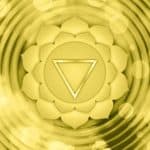
- Position: solar plexus
- Function: power, strength, self-esteem, expansiveness, life awareness, action, will and pleasure
- Color: yellow
- Element: fire
- Sense: Sight and Smell
- Stones: all yellow stones, in particular Calcite, Citrine Quartz and Topaz
- Mantra: Ram, U
- Lotus: 10 petals with a ram inside
- Note: mi
- Animal: ram, symbol of fire
#4 - Anahata: the heart chakra
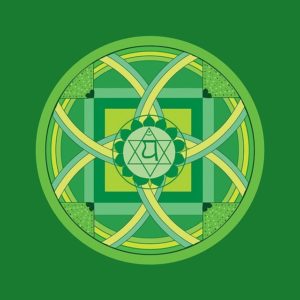
The heart chakra is the most central chakra. It unites the higher, more spiritual chakras, which represent elements that are in the air, with the lower, more material chakras, which represent elements that are on the ground.
The Anahata also represents the air, which unites the earth with the sky. The fourth chakra is therefore a real link between the top and the bottom, between the ground and the spiritual, and this is also demonstrated by the two triangles within it, one with the tip up, to indicate the sky, and one with the tip down, to indicate the earth.
The fourth chakra is closely related to the heart, the circulatory system, lungs, heart plexus, the entire area of the chest and the breathing. It is associated with the color green.
When it is open we are able to love unconditionally, showing ourselves generous with others, caring and heartfelt. But we are not totally dependent on others and we can also love ourselves and our lives.
Physically, the air is able to enter our lungs fluidly, charged with oxygen, which is transported into the rest of the body by a functional circulatory system.
If the fourth chakra is closed, the resulting problems are linked to the affective sphere. We are incapable of loving ourselves first of all and consequently also those around us. We become cold and apathetic, always suspicious and circumspect because we tend not to trust anyone.
If it opens too much, however, our attention will be focused exclusively on others to divert attention from ourselves. But it will not be a disinterested love: we will try to obtain the greatest number of benefits from a relationship, without the intention of giving anything in return.
Other consequences of the malfunctioning of the heart chakra are the inability to love, respiratory and cardiac diseases, selfishness, disconnection and isolation.
Then let's see how to rebalance it.
How to rebalance the fourth chakra
The asanas that help to reopen the fourth chakra are all those where the chest is the protagonist, such as the Anahatasana or the Dhanurasana, and all breathing techniques, such as Pranayama. As always, Reiki can help this chakra to activate and to balance itself.
You can also concentrate by listening to the mantra Yam, the mantra tied to the fourth chakra, while practicing or meditating.
To open this chakra you can also do full-breathing exercises involving large chest openings, help people every day and put aside hatred.
Summary sheet of Anahata

- Position: in the centre of the chest
- Function: love, humility, compassion, generosity, openness to others
- Color: green
- Element: air
- Sense: touch
- Stones: All green stones, in particular Tourmaline and Avventurine
- Mantra: Yam, O
- Lotus: 12 petals with two inverted triangles in the centre forming a 6-pointed star
- Note: fa
- Animal: antelope
#5 - Vishuddha: the chakra of the throat

The Vishuddha chakra is located right at the base of the throat and is connected to the communication, both with others and with ourselves, and to the emotions that result. It controls the neck, throat, hands and arms, and is associated with the bronchial or cervical plexus.
The color of this chakra is light blue and symbolizes transparency. When this chakra is open, in fact, you can express yourself clearly and transparently, with touch, without offending. Your voice is calm and relaxed, you know how to listen to others and you always manage to express what you think and let yourself go.
The opening of the fourth chakra also brings great creativity, which is a very powerful way to express yourself. Our social relationships are pleasant and relaxed, we take an intense interest in others with understanding and without judging.
Our ability to concentrate is also very high. Since we are very predisposed to listening, learning also becomes fast and effective.
On the contrary, the closure of this chakra leads to not being able to express oneself well or to listen to others. We are unable to say no, we feel extremely shy and awkward and we can no longer express our creativity, either through words or through artistic disciplines.
All this leads to a situation of deep discomfort that in the long run can make us close so much in ourselves that we do not want or even be afraid to be together with other people. Needless to say, our social relationships will inevitably disintegrate.
Even at the physical level we can run into problems, first of all the thyroid, but also the breathing and related organs. Illnesses such as asthma, bronchitis, mouth ulcers, speech disorders, but also ear aches and pains will appear.
When the chakra is too open and working too much, we become logorrhoic, never listening to what others tell us. What we say, however, is not what we really think but our conversations will be based on lies and manipulations.
We also feel too self-confident and we do not accept criticism, even when it comes from the people we love.
How to rebalance the fifth chakra
When the fifth chakra is unbalanced, what we have to do is bring out our creativity and learn to appreciate silence and listening.
It doesn't matter if you have a creative block. Try to fight it by painting, writing, dancing or singing, even if the result won't be the best! The important thing is to be able to let go of your emotions.
You can practice Reiki or even yoga asanas that affect your neck and shoulders, such as Matsyasana, also called the position of the fish.
I also recommend you to do meditation, focusing deeply on your breath, maybe listening to the mantra of Vishuddha, the HAM, which you can hear in the video below.
Any other methods to activate the throat chakra? With rotations and movements of the neck, shouting everything you hear in a quiet place, doing vocal exercises, doing singing exercises and pronouncing mantras in a repetitive and systematic way.
Summary sheet of Vishuddha
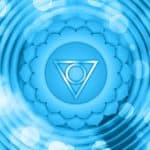
- Position: At the level of the throat, at the crossing of the bones of the clavicle
- Function: communication, opening to others, listening
- Colour: light blue
- Element: ether
- Sense: hearing
- Stones: lapis lazuli, aquamarines all blue stones, especially chalcedony and sodalite
- Mantra: ham, E
- Lotus: 16 petals with a triangle in the centre with the tip pointing downwards
- Note: sol
- Animal: white elephant
#6 - Ajna: the chakra of the third eye
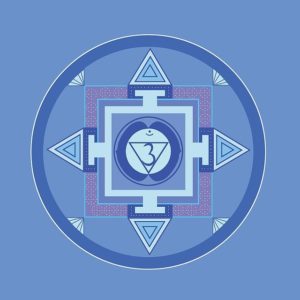
We continue upwards along the path of the kundalini, until we arrive at the penultimate chakra: the chakra of the third eye.
The chakra of the third eye is located in the head, between the eyebrows, and is the symbol of intuition and sight beyond appearances and beyond even reality itself.
It is inevitably connected to the eyes but also to the forehead, temples, brain and spinal cord. In this chakra are connected all opposites and all duality, such as male and female, reason and intuition, form and substance, body and mind, good and bad.
And the third eye sees what exists beyond these concepts, dissolving the duality to get to see the true reality.
If the flow of energy that crosses this fifth chakra is not blocked, we get in tune with our higher self. We become intuitive, aware, concentrated and highly perceptive. We can visualize thoughts and images, empathy amplifies and we can understand what other people think.
We see the world for what it is, in its energy and spirituality, wisely and without prejudice. We can understand the essence of what surrounds us, seeing beyond what we physically see with our eyes.
When Ajna is blocked, we become selfish, cynical, materialistic, cold and calculating. We only trust what we see with our eyes and can no longer perceive what exists beyond.
We can no longer dream or plan our future, we become insensitive and detached, without the ability to stay focused on something for long.
Physically, the head will be affected: headache, migraine, fatigue, insomnia, neurosis, eye pain and even blindness. But the sixth chakra can also be too open and in this case, in addition to the physical pains, we become manic, self-celebrating and tend to blame others for our faults.
It is therefore important that even the sixth chakra is always balanced to maintain inner serenity and a stable relationship with others.
How to rebalance the sixth chakra
To rebalance the third eye chakra, meditation is very important. Through meditation we can communicate with ourselves and with the energy that is around us. Even the practice of Reiki undoubtedly brings you closer to this goal.
It is also important to practice pranayama to learn how to get benefits from our breathing. To open the sixth chakra we can do so by listening to the mantra of the sixth chakra, the om.
In addition to Reiki and meditation, to rebalance the sixth chakra you can do activities that stimulate creativity or immerse yourself in nature, paying attention to the small details of life and contemplating the beauty that surrounds us every day, such as a sunset or a starry sky.
Details that make our existence so beautiful, deep and worth living.
To activate the third eye chakra you can also do guided meditations, visualize simple geometric shapes, massage the temples and eye contour in a circular way, and massage the eyes with the eyelids closed using your fingertips.
Summary sheet of Ajna

- Location: In the middle of the forehead, between the eyebrows
- Function: intuition, imagination, foresight
- Color: purple or indigo
- Element: light
- Sense: sight, sixth sense
- Stones: Amethyst, fluorite, labradorite, lapis lazuli, moldavite, opal, sodalite, sapphire, zircon
- Mantra: om, aum, I
- Lotus: 2 petals with a triangle in the middle with the tip downwards
- Note: la
- Animal: The symbolism does not include a representative animal for this chakra
# 7 - Sahasrara: the crown chakra
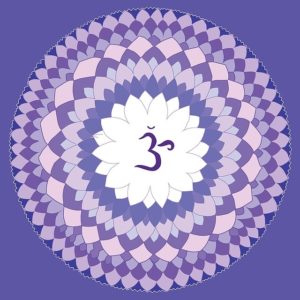
Finally we arrive at the seventh chakra, the highest, the last one that reaches the kundalini in this ascent: the crown chakra.
It is located at the top of your head, just like a crown, and controls the top of the head, the nervous system and the brain. It is associated with the color purple.
The Sahasrara is the chakra of liberation, knowledge and bliss. It is not found in the physical body, but above, above the head. It is linked to the energy of the universe, to the connection with the Divine, to the Enlightenment. Whoever reaches this stage will have understood the mysteries of life, including birth and death.
This chakra is represented by a lotus with a thousand petals, a symbolic number that indicates infinity. Its energy will dissolve your Ego in the Whole and transform us in turn into energy.
The opening of the seventh chakra will give you wisdom, well-being, tranquility and happiness. You will be patient, understanding and compassionate.
But what happens if the energy flow of the seventh chakra is blocked? When the flow is blocked, we will not be able to cultivate our spirituality. We will then feel apathetic, despondent, unwilling to live, depressed.
If it is too open, then we will be attached to unimportant things, material goods and power, overwhelmed by ignorance and dissatisfaction, and we will always feel anxious, arrogant, impatient.
Even on the physical plane we will be affected and suffer from exhaustion, mental confusion, depression, apathy to the point of ending up in psychosis and schizophrenia.
Other problems with this chakra can cause the need to dominate and manipulate others to get what you want, the fact of always wanting to be right, bullying, rigidity in the form of thinking, a high ego, materialistic values, the difficulty in concentrating, the difficulty of thinking independently.
How to rebalance the seventh chakra
In addition to Reiki sessions, the yoga positions that help us rebalance the seventh chakra are those that stimulate the top of the head, such as Sirsasana or Sasangasana, but also Padmasana, also called lotus position, which will help you find the concentration for meditation, perhaps listening to the mantra Ah.
You can also activate the crown chakra with meditation and prayer exercises, you can also try to keep your mind free of thoughts for at least 20 minutes with the help of a mantra and in a sitting position with your back upright.
Summary of Sahasrara

- Position: above the head
- Function: knowledge, universal awareness or pure awareness
- Color: white, deep purple
- Element: Metal
- Sense: thought and empathy
- Stones: hyaline quartz, amethyst, diamond
- Mantra: ah, om, I
- Lotus: a thousand symbolic petals indicating infinity with a light in the middle
- Note: Yes
- Animal: The symbolism does not include a representative animal for this chakra
Useful Resources
The Chakra Essences
The Chakra Essences are deep acting combinations focused on helping you to open and re-balance your most important chakra points. There are ten essences, one for each of the seven main chakra points and three important minor chakra points . These powerful essences offer you the opportunity to work at a deep level with the issues and patterns of each of the chakras that most affect your mental and emotional well being.
Key Points: Re-balancing your chakras | Easy to choose & use | Handmade
Click here to discover them on our partner's website Crystal Herbs Shop.
Also they offer a Complete Chakra Essence set that contain one of each of the ten Chakra Essences and come in an attractive card presentation box.
Chakras' Books
I have selected for you some books about Chakras:
Chakras' Crystals and Other Products
Conclusions
We have come to the end of this long and fascinating journey to discover the 7 chakras.
Together we saw what chakras are, how they work and why it is so important that they are always open and aligned.
Maintaining the balance of the 7 chakras will help you to live a full and serene life, obtaining a perfect relationship with yourself and with the people around you, developing knowledge, beauty and serenity, until you reach a deep peace and harmony with the energy of the universe.
I'm curious about your impressions and experiences. Have you already practiced Reiki and meditation to realign your chakras? What results have you obtained?
Let me know with a comment below.
A hug of light and love.
P.S. I leave you a gift, a complete meditation on the most important chakras, you will find it here:
Discover the Seven Chakras
Click on an image to come back to the corresponding Chakra:
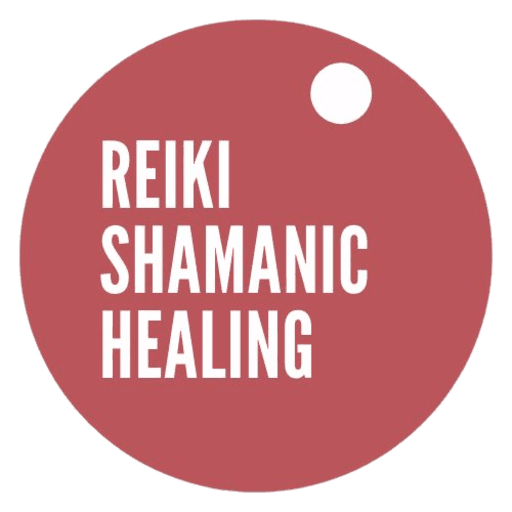
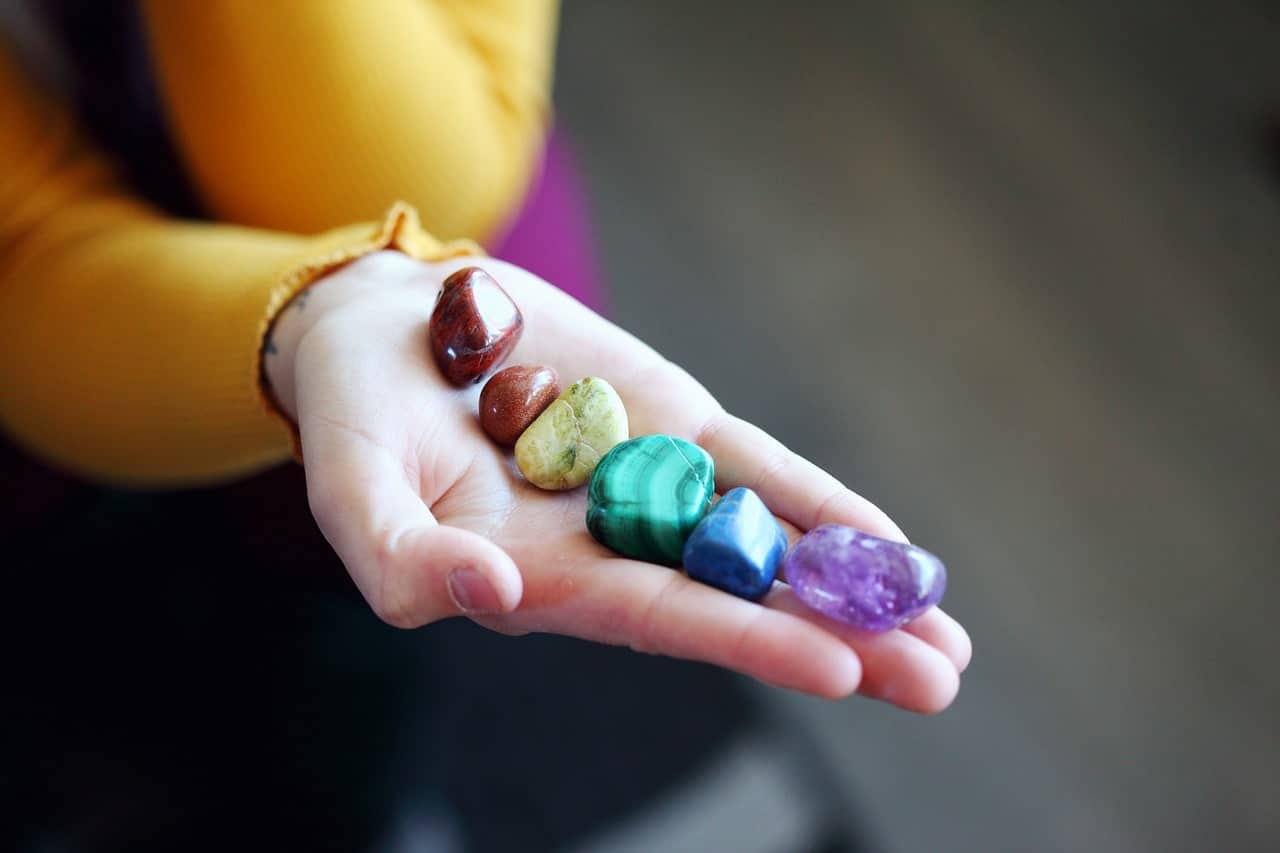



Loved this content totally!!. Especially the details that you have been are very knowledgeable. Hope to get much more content like this!!. Thank you so much!!
wow! I loved the article you wrote so detailed. I have also doing chakra meditation to tune with chakras, however, I have doubt for a very long time that does hearing this music you shared helps to balance chakras? Whenever I search for guided meditation or chakra meditation I always find these videos you shared in this article and always wonder do these sounds balance chakras in our body when we hear them with headphones or chanting is a must?
I would be really glad if you could help me with this doubt!
I found great content here. Thank you for sharing the different chakras of meditation.
Nice to circulate these content about chakras. Useful content it is. Thank you.